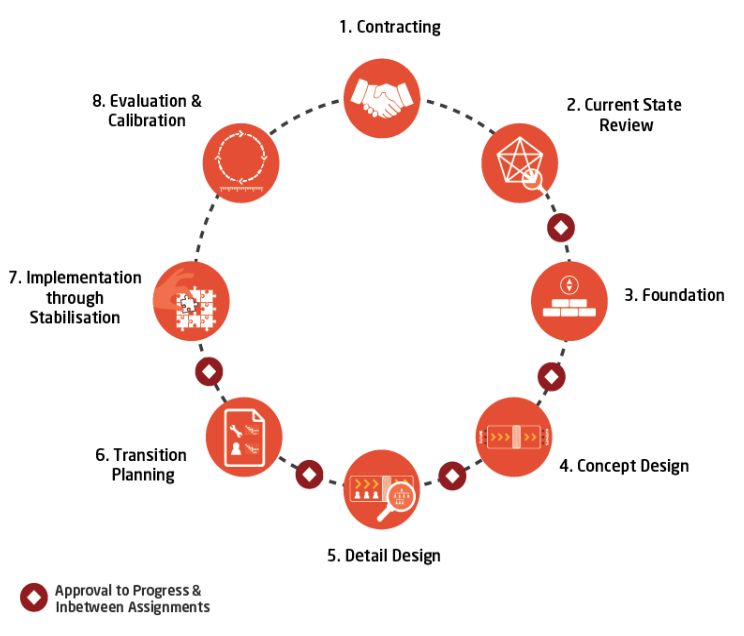11 minute read
Takeaway: Currently, there are many things outside our control; the future of your business’ operating model is not one of them. Spend the time now working virtually as a leadership team to complete a Current State Review of your operating model.
We have previously looked at organizations focussing all their efforts on keeping key services running during the COVID-19 pandemic. Key services include delivering critical health care, maintaining field to fork supply chains or other key services which support a world in lockdown. We hypothesized that successful responses, in whatever form, correlate highly with a leader’s depth of understanding of their operating model. Concluding that organizations that understand all parts of their operating model are the ones that respond with agility to unplanned strategic intent changes. The time they spent previously understanding and designing their operating model means they can change and leverage it quickly. They pay now (during the initial operating model design), rather than pay later (when they have to change the operating model quickly).
Looking Ahead to a New Operating Model
This week we look at organisations that are considering their options for returning to the new normal. These are organizations that have either partially or fully shut down, either because of lack of demand for their products/service or due to government instruction. Many companies have tried to quickly adapt to new ways of working using digital tools and virtual meetings. Some people are asking themselves how sustainable their old ways of working are, and how long they can keep business running in the old way.
Preparing your operating model during this time will help put the company quickly back on track when the pandemic subsides. Forward-thinking leaders, seeing their operating model creak or fail, are looking at factors that have made others successful as they plan for life post-pandemic. Meanwhile, employees now working virtually through force majeure are questioning why they had to previously commute into the office every day.
There Is No Miracle Cure
In our experience, leaders who think their businesses need to change must avoid thinking that they have found a miracle cure. Imposing this top-down cure across their organization during a period of furlough is not the right answer. It seems easy to scan the business environment, see what those who are currently trading successfully have done, and conclude that the answer lies in;
- Removing complexity by reducing the product/service range
- Geographically dispersing the workforce
- Virtual meetings
- Introducing digital collaboration tools
- Investing in Enterprise Resource planning processes and systems
- Standardized ways of working
- New decision-making protocols
- Investing in AI
- A more flexible supply chain
- New approaches to supplier management
- Etc., etc.
The list can be endless and is in fact no different to the list of options that were available before the current crisis began. However, this begs the question: why are these options only being considered now? I’m reminded of a previous OTM redesign project with a business unit that won an award for best in its class in Europe. When asked why he wanted to redesign a ‘best in class’ unit the leader said, ‘standing still was not an option, and change was needed’. (Get the full case study here). Don’t wait for a crisis to make changes, plan to be ahead of the curve.
Why Understanding Your Operating Model Matters for Leaders
As we know, success in quickly changing an operating model is correlated with leaders who really understand their operating model in the first place. They invest time and effort into ensuring their leadership is aligned around their business direction and strategic intent. Then they take a holistic approach to designing and implementing an operating model that is fully fit for purpose. This level of understanding of their business enabled these leaders to quickly make decisions in response to external environmental changes. They already knew the changes were aligned to their operating model and would not have unintended consequences.
Using Uncertainty Wisely to Address Your Operating Model
Now is the time for leaders to consider what their options are for a new normal to use the current period of uncertainty wisely. Now is the time to plan the changes they need to make to their current operating model. Preparing your operating model now will save you time later. To do this successfully it is fundamental that you fully understand the current operating model and answer the question, ‘How fit for purpose is our current operating model?’ This phase of work entails a holistic and comprehensive, critical review of the following:
- strategy
- performance
- customer experience
- value stream
- structure
- management mechanisms
- social system
- ways of working
- culture
This work informs, educates and engages leaders and key stakeholders about the workings of their current business. Critically important, it begins to answer the question, ‘Is there a need to change?’
Utilizing Current State Review to Address the Future
Preparing your operating model post-COVID-19 doesn’t have to be done in person. Using facilitated virtual meetings supported by a digital collaboration toolkit, a leadership team can draw on expertise throughout their organization to complete a Current State Review. In doing this, it is important to address, through scenario testing, the pinch and pain points in the operating model both pre-COVID-19 and now. Then and only then can the leadership team answer the two critical questions; ‘Is our operating model fit for purpose?’ and ‘Do we need to change?’ There is no reason why a leadership team with support from key individuals throughout the organization cannot complete a Current State Review through a series of virtual workshops over a one to two-week period.
“One Size Fits All” Operating Models Don’t Exist
Knowing there is a need to change and knowing what to change are two very different things. The mistake right now is to cherry–pick from a list of nice to have systems, processes and procedures that have been seen elsewhere and expect these to lead to a bright new tomorrow. What you are seeing when you look around at other companies are elements of a unique operating model that successfully delivers that company’s business direction and strategic intent. It is unlikely that an element will plug into your operating model and suddenly make your strategy successful.
Your Current State Review will teach you much about your current operating model. Also telling is the way you, your employees and your key stakeholders respond to the current situation. Now spend time thinking through the Foundations of an ideal future operating model that successfully delivers your strategy. Keep in mind that elements of your Current State operating model will undoubtedly be fit for the future, and that your employees may return with new expectations about the future of work. The purpose of the Foundation Phase is to translate everything you know about your future business environment and direction into a set of design criteria, requirements, parameters and constraints for the future organization design and operating model. A leadership team can complete the Foundation work through a series of virtual workshops over a one-week period.
Take Control of Your Operating Model When You Can
Currently, there are many things outside our control; the future of your business’ operating model is not one of them. Spend the time now working virtually as a leadership team to complete a Current State Review of your operating model. Take into account lessons learned as you went into lockdown, and use this critical review alongside emerging future of work requirements to determine the Foundations of your ideal future state operating model. If you do this now, you will be extremely well-positioned to engage your employees in the development of a Concept Design for your new operating model. Then you can continue to accelerate the building of change readiness through broader involvement in Detail Design and Transition Planning, to Implementation through Stabilisation.
Completing the Current State Review and Foundation work now gives you a win/win in the Pay Now v Pay Later equation. Not only are you using potentially furloughed time constructively, reducing the Pay Now load, you are also jump-starting your critical redesign efforts.
Never miss out on OTM blog updates.
Subscribe to be notified whenever we post.
{{cta(‘a787dd1a-1ff4-4efe-9757-3515e4e4256a’)}}
Peter Turgoose is a Senior Consultant at ON THE MARK.
OTM is the leading global boutique organization design consultancy with offices in the USA and UK. With over 450 successful redesigns and operating model modernizations completed, OTM is owner of the industry’s most integrated, comprehensive and holistic organization design solution. OTM enables its clients to realize their future ambitions.






